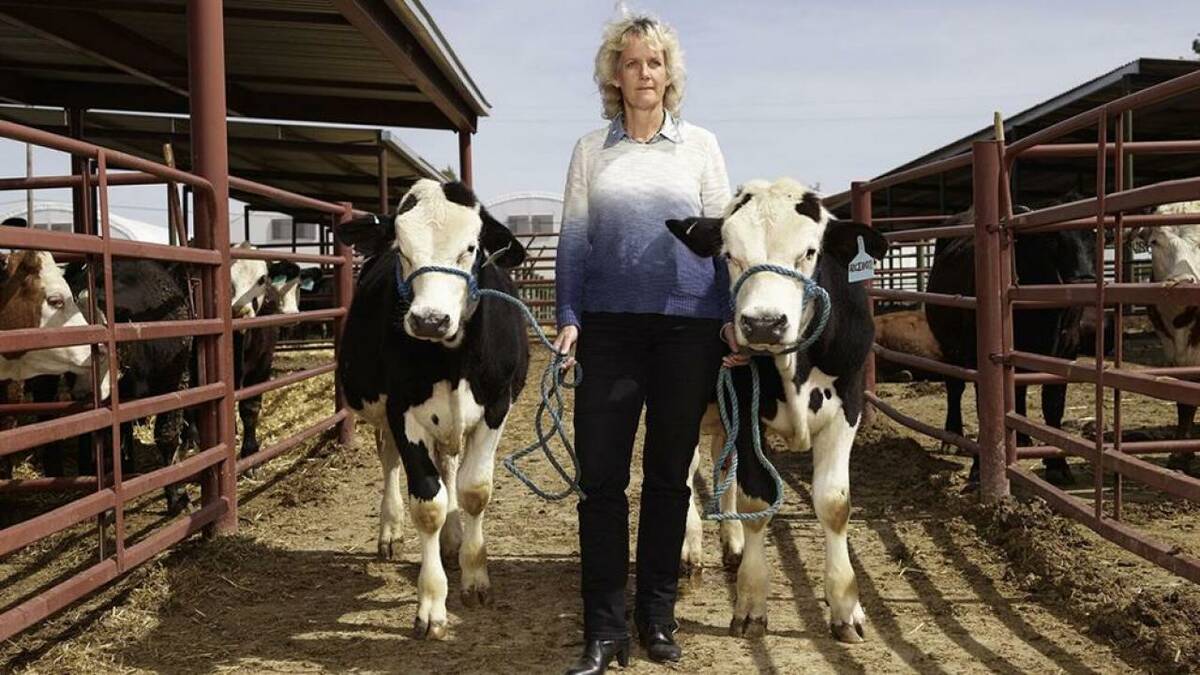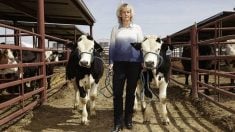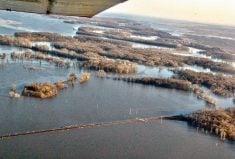MELITA, Man. – Looking out his kitchen window, John Snyder sees a field awash in water and encrusted with ice.
The field has already been flooded by local spring runoff, something Snyder has grown accustomed to. Pumping water from the field is almost an annual rite of passage at the Snyder farm, located a short drive southwest of Melita.
The field rests not far from the Souris River, which meanders through southwestern Manitoba after spilling across the border from the United States.
Snyder can see the river from his house, which is perched on the edge of the Souris River valley. He’s watching the river closely, concerned by the threat of serious flooding this spring.
Read Also

Stacking Canada up on gene editing livestock
Canada may want to gauge how Argentina and other countries have approached gene editing in livestock and what that has meant for local innovation.
“It all depends on the weather,” said Snyder, who farms 250 acres of land in the valley. “If the weather co-operates, it’ll probably be all right.”
Plenty of soil moisture
The province says there is an increased flood threat due to unusually heavy snow cover and high soil moisture throughout most of the watershed. Crests along the Manitoba stretch of the river could be as high as in 1995 and 1996, even with favorable weather.
If that happens, Snyder’s biggest concern will be getting his crop seeded on time. He remembers pumping water non-stop for three days in 1996 due to the flooding.
Pockets of farmland between the U.S. border and Hartney, Man., will be hardest hit if there is serious flooding this spring. Unfavorable weather, such as a fast melt with heavy spring rains, could result in flooding comparable to that of 1976, according to Manitoba’s water resources branch.
Not as bad as 1976
In 1976, Snyder was able to boat to Melita, located less than two kilometres from his farm. The province believes that a flood of that magnitude is unlikely. Snyder hopes that prediction holds true.
“It’s still early,” he said last week. “We’re hoping for the best.”
If the flooding matches that of 1996, the water may not subside until late May, said Alf Warkentin, senior river forecaster for the water resources branch. That would make it a race for farmers wanting to get their fields seeded by early June.
Terry Schuddematt, who farms northeast of Melita, knows all about the frustration of waiting for floodwaters to subside. There have been years, he said, when his fields were planted in late June because of soggy soil.
Because he views the flooding as inevitable, he seeds only green feed on the affected land. The flooding also affects his hayland, causing him to lose part of the production in wet years.
“We were talking about going to a farm auction today,” he said in a March 31 interview.
“I said maybe we’ll hit one with a good boat at it.”
Flooding is an age-old problem at the Schuddematt farm. He wishes something could be done allowing the water to escape from his fields faster, making it possible to do his field work sooner.
Flooding along the Souris River is not expected to pose a serious threat to homes and businesses in the low-lying areas at Melita. Dikes were built and other flood-proofing measures taken in previous years to defend against that risk.
Meanwhile, on the Red River, spring runoff is well under way and the water resources branch believes crests could occur before mid-April with favorable weather.
Flooding of low-lying agricultural lands near the river is likely from Emerson to Morris, Man.
AIDA not bankable: lending manager
By Karen Briere
Regina bureau
news
The general manager of a Saskatchewan credit union says the farm income assistance program is not bankable.
James Duncan, who manages the Dodsland Credit Union, said there is nothing farmers can take to their financial institutions after they have applied for the Agricultural Income Disaster Assistance program.
“Something that’s bankable is saying, ‘You have 1,000 acres, we’re going to pay you $20 an acre, that’s $20,000, and it’s going to be paid to you in the month of June’,” Duncan said.
“That’s bankable.”
He said farmers have to go through a long, complicated process just to fill out the AIDA forms and that doesn’t tell them how much they might get.
One question on the form asks if the applicant is “involved in any non-arm’s length or related transaction that would exceed or be lower than fair market value.”
“Do you understand that question?” Duncan asked.
He said the only advice he can give is to take the forms to an accountant. But if accountants are charging hundreds of dollars for their services, that’s millions of dollars out farmers’ pockets, he said.
For example, if 25,000 of the province’s 55,000 farmers pay their accountants $600, the bill is $15 million.
Duncan said some of his credit union members have told him they will take their chances and not fill out the application.
Provincial agriculture minister Eric Upshall said concerns raised by Duncan and others illustrate AIDA’s shortcomings.
“This thing continues to be very, very much a mess as far as I’m concerned.”
Yet, he encouraged producers to take a stab at filling out the forms.
“We’re finding that there’s no actual pattern to those people who may be getting money and who may not,” Upshall said.
He noted producers can request meetings to help them understand the program and application process. Calls to the AIDA administration to verify this were not returned, but at least one meeting was advertised in a Saskatchewan newspaper.
Duncan also suggested in a letter to Upshall that those who are going to receive money may not get it until fall. He said farmers are going to be too busy to fill out an initial form and then a second 16-page application.
The deadline for submissions is June 15 for individuals, trusts and status Indians and June 30 for corporations, co-operatives and communal organizations.
Upshall said he hopes the money will come in June as has been expected.














